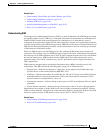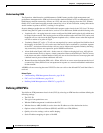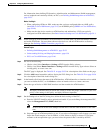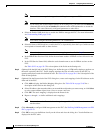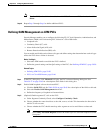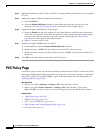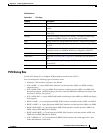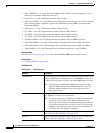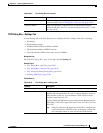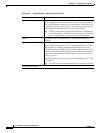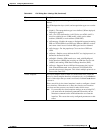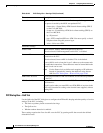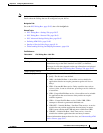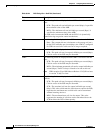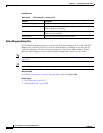
59-57
User Guide for Cisco Security Manager 4.4
OL-28826-01
Chapter 59 Configuring Router Interfaces
PVC Policy Page
PVC Dialog Box—Settings Tab
Use the Settings tab of the PVC dialog box to configure the basic settings of the PVC, including:
• ID settings.
• Encapsulation settings.
• Whether ILMI and Inverse ARP are enabled.
• The maximum number of PPPoE sessions.
• The static domain (VPN service) name to use for PPPoA.
Navigation Path
Go to the PVC Dialog Box, page 59-55, then click the Settings tab.
Related Topics
• PVC Dialog Box—QoS Tab, page 59-60
• PVC Dialog Box—Protocol Tab, page 59-63
• PVC Advanced Settings Dialog Box, page 59-65
• Defining ATM PVCs, page 59-50
Field Reference
Protocol tab Defines the IP protocol mappings configured for the PVC (static maps
or Inverse ARP). See PVC Dialog Box—Protocol Tab, page 59-63.
Advanced button Defines F5 Operation, Administration, and Maintenance (OAM)
settings for the PVC. See PVC Advanced Settings Dialog Box—OAM
Tab, page 59-66.
Table 59-22 PVC Dialog Box (Continued)
Element Description
Table 59-23 PVC Dialog Box—Settings Tab
Element Description
PVC ID settings
VPI The virtual path identifier of the PVC. In conjunction with the VCI,
identifies the next destination of a cell as it passes through a series of
ATM switches on the way to its destination. Valid values for most
platforms range from 0 to 255.
For Cisco 2600 and 3600 Series routers using Inverse Multiplexing for
ATM (IMA), valid values range from 0 to 15, 64 to 79, 128 to 143, and
192 to 207.
Note VPI/VCI values must be unique for all the PVCs configured on
a selected interface. VPI/VCI values are unique to a single link
only and might change as cells traverse the ATM network.



